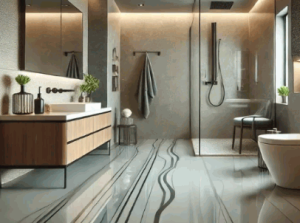
Is Epoxy Flooring Good For Bathrooms
- Interior Design
- August 24, 2024
Epoxy flooring has gained popularity for its durability and aesthetic appeal, making it an intriguing option for various spaces, including bathrooms.
This guide explores what epoxy flooring is and highlights its numerous benefits, such as water resistance and easy maintenance. It also examines the suitability of epoxy for bathrooms, discussing important factors to consider, the installation process, and potential risks.
Whether you’re contemplating a bathroom renovation or simply curious about flooring options like epoxy countertops or decorative epoxy floors, this guide provides valuable insights into epoxy flooring.
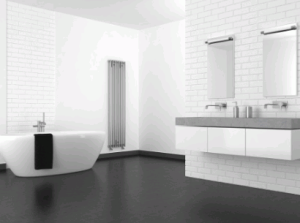
What Is Epoxy Flooring?
Contents
Epoxy flooring is a high-performance flooring solution that combines epoxy resin with various hardeners to create durable floors. This innovative material is renowned for its strength and versatility, making it suitable for a wide range of applications, including residential bathrooms and commercial spaces. With the ability to customize designs using epoxy pigments and resin dyes, homeowners and business owners alike can achieve stunning decorative epoxy surfaces that enhance aesthetics while providing high-impact resistance.
Take a look: Can You Use Floor Epoxy On Countertops

What Are The Benefits Of Epoxy Flooring?
Epoxy flooring offers numerous benefits that make it a popular choice for both residential and commercial spaces. Its impressive durability ensures that surfaces withstand high traffic and heavy use, providing a long-lasting solution that requires minimal maintenance. Additionally, epoxy floors are water resistant, which is particularly advantageous for areas such as bathrooms and kitchens, where spills and moisture are common. For example, epoxy penny floors in public bathrooms can add a unique aesthetic while being easy to maintain. This flooring option also adheres to safety standards, making it a reliable choice for both homes and public facilities.
Durability
One of the standout features of epoxy flooring is its exceptional durability, which makes it a favored choice for high-traffic areas in both residential and commercial spaces. This flooring withstands heavy loads, impacts, and abrasions, ensuring longevity and maintaining its appearance over time. The resilience of epoxy products is particularly important in commercial environments where durability is a key concern, making them a top choice for commercial bathroom flooring.
Several factors contribute to the impressive durability of epoxy flooring, notably its chemical resistance and ability to endure high-impact environments. For example, a professional installation can ensure that epoxy coatings are applied correctly to maximize these benefits. These characteristics make it an ideal choice for a variety of sectors, including those requiring moisture resistance and compliance with safety standards.
- Industrial Warehouses: In places where heavy machinery operates, the flooring must resist both chemical spills and physical impact.
- Retail Spaces: Here, foot traffic and the possibility of dropped items necessitate a robust flooring solution.
- Medical Facilities: Cleanliness and resistance to harsh cleaning agents are critical, making epoxy a reliable option.
In all these scenarios, the longevity of epoxy flooring not only reduces maintenance costs but also enhances safety by providing a smooth, durable surface that can withstand the rigors of daily use.
Water Resistance
The water-resistant properties of epoxy flooring are a significant advantage, especially in moisture-prone areas like bathrooms and kitchens. This feature prevents water damage, making epoxy bathroom floors and epoxy shower walls ideal solutions for residential and commercial applications. The seamless surface also eliminates the risk of mold and mildew growth, enhancing hygiene in these spaces. For commercial spaces, choosing the right epoxy coatings is crucial for maintaining sanitary conditions.
Plus its remarkable durability, the epoxy flooring system is engineered to perform well in wet environments, offering a fantastic alternative to traditional flooring materials. For example, epoxy resin can be used to create custom patterns that are both aesthetically pleasing and functional. When considering installation, it’s essential to prepare the substrate thoroughly to ensure proper adhesion. This includes cleaning, leveling, and, if necessary, applying a moisture barrier to enhance water resistance further.
- One crucial aspect of maintenance is regular cleaning; using a mild detergent and avoiding harsh chemicals can prolong the life of the flooring.
- Avoid standing water, as even moisture-resistant surfaces can degrade if not properly managed.
By following these guidelines, one can maximize the effectiveness of epoxy flooring in areas exposed to frequent moisture, ensuring a long-lasting and functional space. For example, UltraClear Epoxy offers products specifically designed for high-moisture environments.
Easy Maintenance
Epoxy flooring is celebrated for its easy maintenance, making it an attractive choice for busy households and commercial establishments alike.
The smooth, non-porous surface of epoxy prevents dirt and grime from accumulating, allowing for quick and easy cleaning with minimal effort. Regular maintenance tips include simple sweeping and mopping, ensuring that the flooring remains in pristine condition without the need for extensive upkeep. For example, using a mild detergent and following specific maintenance tips can prolong the life of the flooring.
Homeowners and business owners will find that incorporating a weekly cleaning routine not only enhances the appearance of the flooring but also extends its lifespan.
- To keep the surface sparkling, use a soft-bristle broom or a vacuum with a hard floor attachment.
- Mopping should be done with a pH-neutral cleaner to avoid any damage to the epoxy.
- For stubborn stains, a damp cloth and a mild detergent can work wonders.
Elements such as foot traffic, spills, and the environment can influence the frequency of these maintenance practices, thus it’s advisable to adapt the approach according to the specific setting.
The inherent durability of epoxy flooring means that it holds up exceptionally well against wear and tear, making it a cost-effective choice for both residential and commercial spaces.
Versatility In Design
Epoxy flooring is incredibly versatile in design, allowing for a range of aesthetics that can suit any taste or style. This versatility extends to commercial spaces, where epoxy can be tailored to fit specific design needs.
With options for decorative epoxy finishes, homeowners can create custom patterns and designs using various epoxy pigments and resin dyes, making the flooring a unique expression of personal style. This flexibility means that epoxy flooring is not only functional but also a significant design element in spaces like living rooms, kitchens, and commercial settings.
Homeowners can choose from an array of colors, including vibrant hues and subtle pastels, to match their existing decor. :
- Marble effects
- Metallic finishes
- Solid colors
can be used to add depth and texture, transforming ordinary flooring into a striking visual centerpiece.
For instance, a metallic epoxy floor in a modern kitchen adds sophistication, while a bold color pattern can energize a playroom. The ability to combine these elements not only enhances aesthetics but also provides practical benefits such as durability and easy maintenance, making epoxy an ideal choice for both residential and commercial spaces.
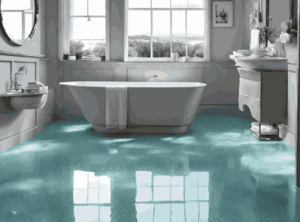
Is Epoxy Flooring Suitable For Bathrooms?
Epoxy flooring is exceptionally suitable for bathrooms, thanks to its moisture-resistant properties and seamless application. For example, epoxy bathroom floors and epoxy shower walls offer both style and durability. The durability and ease of maintenance make epoxy bathroom floors a preferred choice for homeowners who want a stylish yet practical flooring solution. Plus being visually appealing, epoxy shower walls offer a waterproof barrier, preventing water infiltration and potential damage.

What Are The Factors To Consider?
When considering epoxy flooring for bathrooms, several important factors must be taken into account to ensure a successful installation and long-lasting performance. These factors include moisture levels, which can significantly impact the flooring’s effectiveness, as well as the condition of the subfloor and the overall ventilation in the space. Evaluating these aspects will help determine if epoxy flooring is the right choice for your bathroom environment.
First and foremost, moisture control is essential, given that bathrooms are inherently humid environments. High moisture can compromise the bond strength between the epoxy and the subfloor, leading to potential peeling or delamination over time.
Likewise, the condition of the subfloor plays a pivotal role; a damaged or uneven surface can hinder the application process and affect the overall durability of the flooring. Adequate ventilation can mitigate excess humidity, thus extending the longevity of the flooring solution.
To prepare the surfaces effectively for installation, a thorough cleaning is crucial. This involves:
- Removing any existing flooring material to expose the subfloor and ensure clean surfaces.
- Cleaning the surface to eliminate dirt, grease, and contaminants.
- Repairing any cracks or imperfections to ensure a smooth application.
By addressing these key aspects, property owners can achieve a flawless installation that enhances both the aesthetic appeal and functionality of their bathrooms.
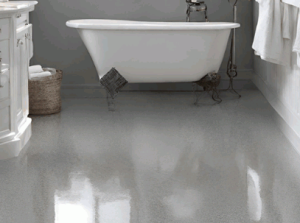
Moisture Levels
Moisture levels play a critical role in the longevity and performance of epoxy flooring, especially in bathrooms where humidity is often high. If moisture levels are too high, it can lead to water damage and compromise the integrity of the flooring. As such, assessing moisture levels prior to the installation process is essential in ensuring that the epoxy flooring adheres properly and performs as intended. Only with adequate preparation can homeowners enjoy the benefits of a durable and aesthetically pleasing surface.
To effectively measure and control moisture levels in bathrooms, homeowners can utilize various methods and tools:
- Moisture Meters: Investing in a reliable moisture meter is crucial. These devices can accurately assess the moisture content in both the air and the floor substrate.
- Ventilation Techniques: Proper ventilation helps in reducing humidity. Installing exhaust fans or opening windows can significantly lower moisture levels.
- Dehumidifiers: A dehumidifier can be an excellent solution for particularly damp environments, actively removing excess moisture from the air.
Implementing these practical solutions ensures that moisture remains under control, which is vital for maintaining the integrity of epoxy flooring over time. In turn, this contributes to reduced repair costs and a more functional bathroom environment. For the best results, consider using UltraClear Epoxy as it offers superior durability and moisture resistance.
Ventilation
Proper ventilation is essential in bathrooms where epoxy flooring is installed, as it helps control humidity and improve air quality. Inadequate ventilation can lead to moisture buildup, potentially undermining the effectiveness of the epoxy flooring and creating an environment conducive to mold and mildew growth. Therefore, ensuring good airflow is crucial for the longevity of both the flooring and the overall bathroom health.
In fact, without sufficient airflow, not only can the epoxy suffer from degradation, but the bathroom can also become a breeding ground for various harmful microorganisms. The presence of excessive humidity is particularly detrimental as it creates an inviting atmosphere for mold, which poses health risks and contributes to persistent odors.
Ventilation plays a key role here, and there are several practical steps one can take to enhance airflow in this space:
- Install exhaust fans that effectively remove moisture-laden air, especially during and after showers.
- Ensure windows can be opened to welcome fresh air whenever weather permits.
- Keep doors open when possible to create cross-ventilation that promotes air movement.
- Consider using dehumidifiers to help maintain optimal humidity levels, particularly in more humid climates.
By implementing these strategies, not only will the integrity of the epoxy flooring be preserved, but a healthier bathroom environment will also be cultivated.
Subfloor Condition
The condition of the subfloor is a vital consideration when installing epoxy flooring, as it directly affects the adhesion and performance of the epoxy. A clean and well-prepared surface is necessary to achieve optimal results, preventing issues like peeling or bubbling. Understanding the requirements for proper surface preparation can significantly enhance the durability of the epoxy flooring in bathrooms.
To begin the assessment, it is crucial to inspect the subfloor for any signs of damage, including cracks, moisture exposure, or uneven surfaces. Each of these factors can jeopardize the integrity of the finished flooring. Here’s a streamlined approach to ensure the subfloor is ready:
- Clean the Surface: Clear away any debris, dust, or contaminants using a vacuum and a damp mop.
- Check for Moisture: Perform a moisture test to gauge humidity levels. Excessive moisture can compromise adhesion.
- Repair Imperfections: Fill any cracks or holes with an appropriate compound and allow it to dry thoroughly.
- Level the Surface: If there are irregularities, consider using a self-leveling compound to create an even base.
Taking the time to meticulously prepare the subfloor not only facilitates the installation process but also extends the life of the epoxy flooring, ensuring it remains visually appealing and functional.
What Are The Potential Risks Of Using Epoxy Flooring In Bathrooms?
While epoxy flooring presents numerous advantages, there are potential risks associated with its use in bathrooms that homeowners should be aware of. One such risk is the possibility of a slippery surface when wet, which can pose safety concerns, particularly in family households or public bathrooms. Additionally, discoloration and fading can occur over time if the flooring is not maintained properly, making it essential to understand these risks before installation.
Slippery Surface
One of the primary concerns regarding epoxy flooring in bathrooms is the potential for a slippery surface, especially when water accumulates. This can be particularly troublesome in high-traffic areas and may pose a risk to the safety of users, especially children and the elderly. Ensuring that the epoxy flooring meets safety standards for traction is crucial in mitigating this risk and providing a safe environment. Safety in design is paramount.
To address the traction issues associated with epoxy flooring, there are effective strategies available that can significantly enhance safety without sacrificing style. For example, incorporating anti-slip additives into the epoxy mixture during installation can provide a more secure surface.
- Consider using aluminum oxide or silica sand, both of which are popular additives that improve grip.
- Choose epoxy formulations designed specifically with anti-slip properties; these products often provide a textured finish that enhances traction.
Plus additives, it’s wise to regularly maintain the flooring to prevent slick conditions caused by spills or moisture buildup. For instance, using cleaning products that do not leave a residue can be beneficial. Ensuring the right blend of safety and design will result in a bathroom environment that remains aesthetically pleasing while prioritizing user safety.
Discoloration
Discoloration is another potential risk associated with epoxy flooring, particularly in bathrooms that receive direct sunlight or UV exposure. Over time, certain pigments and coatings may fade, altering the original look of the flooring. To combat this issue, it is important to consider UV-resistant epoxy products and follow maintenance tips that help preserve the flooring’s color integrity.
There are several factors that can contribute to the fading and discoloration of epoxy surfaces. One of the main culprits is prolonged exposure to sunlight, which can degrade the chemical composition of the epoxy. Some cleaning agents or harsh chemicals can react negatively with the epoxy, causing unwanted stains or discoloration. To minimize these risks, selecting a high-quality epoxy that is specifically formulated to resist UV rays and staining is essential. UltraClear Epoxy is known for its excellent UV resistance. It’s also advisable to:
- Apply protective coatings when necessary to provide an extra layer of defense against the elements.
- Regularly clean the floor using gentle cleaning solutions that are compatible with epoxy surfaces.
- Consider using area rugs or mats in high-traffic or sunlit areas to shield the flooring from excessive light exposure.
Implementing these preventive measures can significantly enhance the durability and aesthetic appeal of the flooring, ensuring that your investment remains in excellent condition for years to come.
Fading
Fading is a common concern with epoxy flooring, particularly when exposed to harsh conditions or inadequate maintenance. Regular exposure to water, heat, and cleaning agents can contribute to fading over time, which is why proper care is essential. Implementing maintenance tips can significantly extend the life and visual appeal of epoxy flooring, ensuring it remains an attractive feature in both residential and commercial bathrooms.
To effectively combat fading, several factors must be considered. Selecting high-quality epoxy products is paramount as these products often come with enhanced UV resistance and durability, ensuring that colors don’t dull over time.
- Use a proper sealant: Applying a suitable sealant can provide an extra layer of protection against wear and tear.
- Regular cleaning: Routine maintenance with mild detergents can prevent the buildup of dirt and grime that might contribute to fading.
- Avoid harsh chemicals: Opt for gentle cleaning agents rather than acidic or abrasive cleaners that could wear down the finish.
In addition, ensuring adequate ventilation and minimizing direct sunlight can also help maintain the vibrancy of epoxy flooring, ultimately enhancing its longevity and aesthetic appeal.
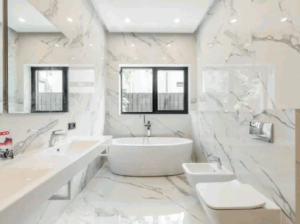
How To Properly Install Epoxy Flooring In Bathrooms?
Proper installation of epoxy flooring in bathrooms is crucial for achieving long-lasting results and optimal performance. The installation process involves several critical steps, including thorough surface preparation, mixing the epoxy resin and hardener correctly, and applying the epoxy coatings in a methodical manner. Engaging in professional installation ensures that all aspects of the installation meet high safety standards and performance expectations.
Preparing The Subfloor
Preparing the subfloor is a fundamental step in the installation of epoxy flooring, as it lays the groundwork for a successful application. This process involves cleaning the surfaces thoroughly, repairing any imperfections, and ensuring that the subfloor is structurally sound. Effective surface preparation is essential to achieve strong adhesion and prevent future problems such as bubbling or peeling.
To begin with, it’s crucial to assess the condition of the existing subfloor. Look for cracks, holes, and moisture issues that may compromise the integrity of the surface. Next, proper cleaning methods should be employed. This can include:
- Use a vacuum cleaner to remove dust and debris
- mopping with a suitable solvent to eliminate grease
- scraping away any old adhesive or coatings that could interfere with adhesion.
After achieving a clean surface, any damages should be repaired using dedicated patching compounds, ensuring a smooth finish. A moisture test is recommended; this will help determine the compatibility of the UltraClear Epoxy with the subfloor and prevent future complications.
Ensuring a clean and suitable surface not only maximizes the lifespan of the flooring but also enhances the overall aesthetic appeal, making it a worthwhile endeavor.
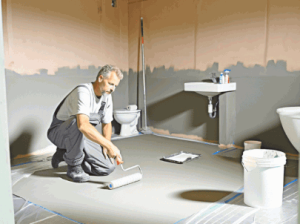
Applying The Epoxy Coating From Best Coast Epoxy Coatings
Once the subfloor has been properly prepared, the next step in the installation process is to apply the UltraClear Epoxy coating. This involves mixing the epoxy resin and hardener in the correct ratios, followed by pouring the mixture onto the prepared subfloor. Careful application techniques are required to ensure an even distribution and to avoid air bubbles during the process.
Before starting, it is crucial to choose the right tools to facilitate a smooth finish. Consider the following techniques:
- Use a notched trowel: This helps spread the epoxy evenly across the surface. Ensure that the trowel is held at a consistent angle to maintain an even layer.
- Rollers are your best friends: A high-quality roller can assist in eliminating air bubbles that may form during application. Opt for a roller with a medium nap to ensure coverage without leaving behind fibers.
- Timing is essential: Epoxy must be applied within a specific timeframe after mixing, so be mindful of the working time indicated on the packaging.
- Environmental factors matter: Ensure that the temperature and humidity are within the recommended levels for optimal curing.
By following these practical tips and being aware of the conditions and tools used, smooth and durable epoxy flooring can be achieved, enhancing the aesthetic and longevity of the surface.
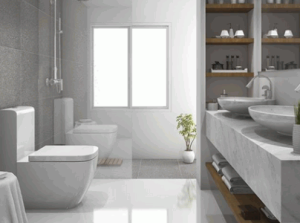
Adding A Protective Topcoat
After the epoxy coating has fully cured, adding a protective topcoat is a crucial step to enhance the durability and longevity of the flooring.
This topcoat provides an additional layer of protection against wear and tear, UV exposure, and moisture, ensuring the epoxy flooring retains its appearance and functionality over time.
For those considering this enhancement, it’s essential to explore the various types of protective topcoats available, which include polyurethane, polyurea, and acrylic options. Each type offers unique advantages, such as greater flexibility or prolonged resistance to chemicals.
- Polyurethane: Known for its hardness and scratch resistance.
- Polyurea: Offers rapid drying and exceptional durability.
- Acrylic: Provides a more affordable solution with decent protection.
The application process typically involves ensuring that the epoxy surface is clean and dry before evenly applying the chosen topcoat. By investing time in this step, one greatly enhances the lifespan of the flooring, ultimately saving on repair and replacement costs.
To maintain this protective layer, regular cleaning, and occasional reapplication are advisable to keep the surface in top condition.
How To Maintain Epoxy Flooring In Bathrooms?
Maintaining epoxy flooring in bathrooms is essential to ensure its longevity and aesthetic appeal. Regular cleaning practices, such as sweeping and mopping, help prevent dirt accumulation and keep the surfaces looking fresh. Additionally, avoiding harsh chemicals during cleaning and promptly addressing any damages are key maintenance tips that contribute to the overall lifespan of epoxy floors.
Regular Cleaning
Regular cleaning is a crucial aspect of maintaining epoxy flooring, as it prevents dirt and grime buildup that can detract from the floor’s appearance and performance. A simple routine of sweeping and mopping with mild detergents can keep the surfaces looking pristine and prolong the life of the flooring.
To effectively care for this type of surface, incorporate a few essential steps into your routine:
- Use a Soft Broom or Vacuum: Begin by removing loose debris. A soft-bristled broom or a vacuum with a non-abrasive attachment will ensure no scratches disrupt the glossy finish.
- Mop with Care: When mopping, dilute a mild pH-neutral cleaner in warm water. This effective solution helps lift stubborn stains without harming the epoxy.
- Spot Clean: For spills or stubborn stains, quick action is key. Blot the area rather than scrubbing, as this minimizes damage.
Maintaining a consistent cleaning schedule—ideally once a week—will not only enhance the longevity but also ensure the flooring remains visually appealing over time.

Avoiding Harsh Chemicals
When cleaning epoxy flooring, it is important to avoid harsh chemicals that can damage the surface and lead to discoloration or fading. Opting for pH-neutral cleaning solutions is advisable to maintain the integrity of the epoxy without compromising its appearance.
Utilizing appropriate cleaning methods not only ensures longevity but also enhances the overall aesthetic appeal of the flooring. Many commonly used household products can pose a risk to epoxy surfaces.
To assist in making safer choices, here are some options to consider:
- Avoid products with ammonia or bleach, which can weaken the epoxy’s structure.
- Refrain from using abrasive scrubbers that may scratch the surface.
- Instead, opt for gentle soap solutions or vinegar diluted in water.
Understanding the chemical interactions between cleaning agents and epoxy is crucial in preventing unintended consequences. Regular maintenance using appropriate products fosters a protective barrier, ensuring that the flooring remains resilient and visually appealing.
Repairing Any Damages
Promptly addressing any damages to epoxy flooring is vital to maintain its integrity and prevent further deterioration. Repairing damages involves assessing the extent of the issue, properly cleaning the affected area, and applying suitable epoxy repair products to restore the surface.
To effectively tackle this task, homeowners should first evaluate the specific type of damage—whether it’s a scratch, a chip, or a more extensive crack. Each of these issues may require a different approach for repair. Here’s a straightforward method to follow:
- Assess the Damage: Determine how deep and wide the damage is. For minor scratches, a simple touch-up may suffice, while deeper chips might call for a more comprehensive repair.
- Clean the Area: Use a gentle cleaner to remove any dirt or debris from the affected region. This ensures that the epoxy adheres properly during the repair process.
- Choose the Right Epoxy Product: Select a product specifically designed for your flooring type. There are various kits available that include everything needed to make a successful repair.
- Apply the Epoxy: Follow the manufacturer’s instructions on mixing and applying the epoxy. Use a putty knife for even application.
- Allow It to Cure: Make sure to give the repaired area ample time to cure before walking on it to prevent further damage.
Implementing preventive measures can significantly reduce the likelihood of damage to epoxy flooring. Simple steps such as using furniture pads, avoiding sharp objects on the surface, and regularly cleaning the floor will help maintain its beauty and longevity.
